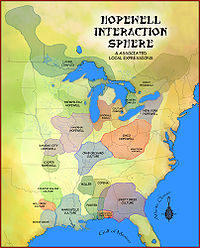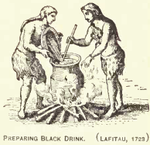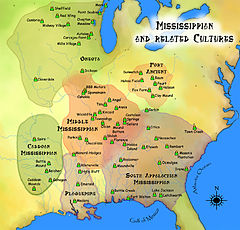- Black drink
-
 Chief Saturiwa prepares his men for battle, from Plate XI of Jacques le Moyne des Morgues' engraving of Fort Caroline", Jacques le Moyne and Theodor De Bry. Photo credit The Florida Center for Instructional Technology, University of South Florida
Chief Saturiwa prepares his men for battle, from Plate XI of Jacques le Moyne des Morgues' engraving of Fort Caroline", Jacques le Moyne and Theodor De Bry. Photo credit The Florida Center for Instructional Technology, University of South Florida
Black drink (sometimes known as white drink because of its connection to purification) was the name given by colonists to a ritual beverage called Asi, brewed by Native Americans in the Southeastern United States. It is thought to have been prepared from the roasted leaves and stems of the Yaupon Holly (Ilex vomitoria), native to the Atlantic and Gulf Coasts, though it may also have been a concoction of other roots and herbs.[1] The active ingredient in the Yaupon drink was caffeine and it was often used as a substitute for coffee and tea by colonists under the name cassine or cassina. Black drink may also have had emetic properties.
Prior to the 19th century, the black drink was consumed during the daily deliberations of the village councils and at all other important council meetings. Caddo, Creeks, Cherokees, Choctaws, and others believed it purified the drinker and purged him of anger and falsehoods. Black drink was prepared by special village officials and served in large communal cups, frequently made of whelk shell. The men in council were served in order of precedence, starting with important visitors. They consumed large quantities at a sitting. Afterward, they purged themselves by vomiting.
Contents
Preparation
According to the ethnohistorical record, the yaupon leaves and branches used for the black drink were picked as close to the time of its planned consumption as possible. After picking they were lightly parched in a ceramic container over fire. The roasting makes the caffeine soluble, which is the same reason coffee is also roasted. After browning, they were boiled in large containers of water until the liquid reached a dark brown or black color, giving it its name. The liquid was then strained into containers to cool, until it was cool enough to not scald the skin, and drunk while still hot. Because caffeine is 30 times more soluble in boiling water than room temperature water, this heightened its effect. It was then consumed in a ritual manner. Its physiological effects are mainly those of massive doses of caffeine. Three to six cups of strong coffee is equal to 0.5 to 1.0 grams of caffeine; the black drink could have delivered at least this much and possibly up to 3.0 to 6.0 grams of caffeine.[2]
Precolumbian use
Archaeologists have demonstrated the use of the Black Drink among Native American groups stretching back far into antiquity, possibly dating to Late Archaic times. During the Hopewell period, the shell cups known from later black drink rituals become common in high status burials along with mortuary pottery and engraved stone and copper tablets. The significance of the shell cups may indicate the beginning of black drink ceremonialism. The fact that both the shells and the yaupon holly come from the same geographical location may indicate they were traded together in the Hopewell Interaction Sphere.[3] The appearance of shell cups can be used as a virtual marker for the advent of Hopewell Culture in many instances.[4] During the Mississippian culture period, the presence of items associated with the black drink ceremony had spread over most of the south, with many hundreds of examples from Etowah, Spiro, Moundville and Hiwassee Island.
Shell cups
 A dancing shaman design taken from an engraved shell cup found at Spiro.
A dancing shaman design taken from an engraved shell cup found at Spiro.
 The Columnella Pendant Motif from an engraved shell cup found at Spiro
The Columnella Pendant Motif from an engraved shell cup found at Spiro
In historic accounts from the 16th and 17th century, black drink is usually imbibed in rituals using a cup made of marine shell. Three main species of marine shells have been identified as being used as cups for the black drink, lightning whelk, emperor helmet, and the horse conch. The most common was the lightning whelk, which has a left-handed or sinistral spiral. The left-handed spiral may have held religious significance because of its association with dance and ritual. The center columnella, which runs longitudinally down the shell, would be removed, and the rough edges sanded down to make a dipper like cup. The columnella would then be used as a pendant, a motif that shows up frequently in Southeastern Ceremonial Complex designs. In the archaeological record columnella pendants are usually found in conjunction with bi-lobed arrows, stone maces, earspools, and necklace beads(all of which are motifs identified with the falcon dancer/warrior/chunkey player mythological figure).[5] Artifacts made from these marine shells have been found as far north as Wisconsin and as far west as Oklahoma. Several examples of cups from Moundville and Spiro have been found to have rings of black residue in the bottoms, suggesting they were used for black drink rituals. Many examples of shell cups found in Mississippian mounds are engraved with S.E.C.C. imagery. A few examples portray what is theorized to be black drink rituals, including what may be vomit issuing from the mouths of mythological beings.[3]
Post-European contact
Many tribes across the Southeastern United States continue using the black drink long after the collapse of the Mississippian cultures. Muscogee Creeks, Cherokees, Choctaws, Ais, Guale, Chickasaws, Chitimacha and many others are documented users of the drink. Although rituals vary amongst the different tribes, there are common traits which span most of the tribal variations. Black drink was forbidden to women, and it is taboo for them to even help in its preparation.
In some ceremonies the drink, after its preparation, is passed out to the highest status person first, then the next highest status, and so forth. During each persons turn to drink, ritual songs were sung (Yahola,[6] the ritual name Asi Yahola or Black Drink Singer is corrupted into English as Osceola).[7]
The black drink is a purifier, that removes spiritual and physical contamination from the drinker, and as such is never taken casually, even when taken daily. Some tribes practice ritual vomiting after its consumption, possibly to heighten its purgative and purifying powers, by expelling contamination from the body. The sharing of tobacco is also a part of the ritual.[6]
Black drink among the Cherokee
 16th-century engraving by Jacques le Moyne of an Indian ceremony involving the black drink
16th-century engraving by Jacques le Moyne of an Indian ceremony involving the black drink
Cherokee black drink is taken for purification and renewal at stomp dances, Green Corn ceremony, and other ceremonies. Made with Ilex vomitoria, the Black Drink reportedly induces vomiting during Cherokee purification ceremonies but, as explained above, this behavior is deliberate or the result of the quantity imbibed, not due to the chemical properties of the drink itself. Other ritual medicinal beverages are also used in ceremonies in Oklahoma.
Cassina use by the Ais
In 1696, Jonathan Dickinson witnessed the use of a beverage brewed from the Yaupon Holly among the Ais of Florida. Dickinson later learned that the Spanish called the plant "casseena". The Ais parched the leaves in a pot, and then boiled them. The resulting liquid was then transferred to a large bowl using a gourd that had a long neck with a small hole at the top, and a 2-inch-wide (51 mm) hole in the side. The gourd was slowly dipped into the brewing pot, which caused a whistling sound as air was forced out through the small hole at the top. The gourd was used to froth the liquid (Dickinson does not specify how). The brewed liquid was a deep brown in color. On the occasion Dickinson witnessed, he estimated that there was nearly three gallons of the beverage in the bowl. After the liquid had cooled, the chief was presented with a conch-shell of the beverage. The chief threw part of it on the ground and drank the rest. The chief's associates were then served in turn. Lower status men, women and children were not allowed to touch or taste the beverage. The chief and his associates sat drinking this brew, smoking and talking for most of the day. In the evening the bowl that had held the beverage was covered with a skin to make a drum. The Ais, accompanied by the drum and some rattles, sang and danced until the middle of the night. Dickinson makes no mention of purging or vomiting by the Ais after drinking this beverage.
Notes
- ^ Gibbons, E. (1964). Stalking the Blue-eyed Scallop. David McKay Company, Inc. ISBN 0-911469-05-2.
- ^ Hudson, Charles M. (1976). The Southeastern Indans. p. 226.
- ^ a b Hudson, Charles M. (1979). Black Drink: A Native American Tea. University of Georgia Press. p. 83–112.
- ^ Griffin, James B. (1952). "Culture Periods in Eastern United States Archaeology. University of Chicago Press. p. 360.
- ^ F. Kent Reilly and James Garber, ed (2004). Ancient Objects and Sacred Realms. University of Texas Press. pp. 86–96. ISBN 9780292713475.
- ^ a b Hudson, Charles M. (1979). Black Drink: A Native American Tea. University of Georgia Press. p. 126–137.
- ^ "Native Americans". http://www.npg.si.edu/col/native/osceola.htm. Retrieved 2008-09-17.
References
- Hudson, Charles M. (1979). Black Drink: A Native American Tea. University of Georgia Press. ISBN 0-8203-0462-X
- Hale, Edwin Moses (1891). Ilex Cassine: The aboriginal North American tea : its history, distribution, and use among the native American Indians. Bulletin U.S. Dept. of Agriculture. Division of Botany.
- Andrews, Charles Mclean and Andrews, Evangeline Walker (1945). Jonathan Dickinson's Journal or, God's Protecting Providence. Being the Narrative of a Journey from Port Royal in Jamaica to Philadelphia between August 23, 1696 to April 1, 1697. Yale University Press. Reprinted 1981. Florida Classics Library.
See also
 Hopewellian peoplesWoodland period · List of Hopewell sites · Mound builder (people) · List of archaeological periods (North America)
Hopewellian peoplesWoodland period · List of Hopewell sites · Mound builder (people) · List of archaeological periods (North America)Ohio Hopewell Beam Farm · Benham Mound · Cary Village Site · Cedar-Bank Works · Dunns Pond Mound · Ellis Mounds · Ety Enclosure · Ety Habitation Site · Fort Ancient · Fortified Hill Works · Great Hopewell Road · High Banks Works · Hopeton Earthworks · Hopewell Culture National Historical Park · Indian Mound Cemetery · Keiter Mound · Marietta Earthworks · Moorehead Circle · Mound of Pipes · Nettle Lake Mound Group · Newark Earthworks · Oak Mounds · Perin Village Site · Portsmouth Earthworks · Seip Earthworks and Dill Mounds District · Shawnee Lookout · Tremper Mound and Works · Williamson Mound Archeological District
Crab Orchard culture Goodall Focus Goodall Site · Norton Mound GroupHavana Hopewell culture Kansas City Hopewell Marksville culture Miller culture Point Peninsula Complex Swift Creek culture Etowah Indian Mounds · Leake Mounds · Kolomoki Mounds Historic Park · Miner's Creek site, · Nacoochee Mound · Swift Creek mound site · Yearwood siteOther Hopewellian peoples Armstrong culture · Copena culture · Fourche Maline culture · Laurel Complex · Saugeen Complex · Old Stone Fort (Tennessee)Exotic trade items Related topics · Ancient Monuments of the Mississippi Valley · Black drink · burial mound · Calumet (pipe) · Effigy mound · Hopewell pottery · Horned Serpent · Eastern Agricultural Complex · Underwater panther Pre-Columbian North America
Pre-Columbian North AmericaArchaeological cultures North American pre-Columbian chronology – Adena – Alachua – Ancient Pueblo (Anasazi) – Baytown – Belle Glade – Buttermilk Creek Complex – Caborn-Welborn – Calf Creek – Caloosahatchee – Clovis – Coles Creek – Deptford – Folsom – Fort Ancient – Fort Walton – Fremont – Glades – Glacial Kame – Hopewell (List of Hopewell sites) – Hohokam – Leon-Jefferson – Mississippian (List of Mississippian sites) – Mogollon – Monongahela – Old Cordilleran – Oneota – Paleo-Arctic – Paleo-Indians – Patayan – Plano – Plaquemine – Poverty Point – Prehistoric Southwest – Red Ocher – Santa Rosa-Swift Creek – St. Johns – Steed-Kisker – Tchefuncte – Tocobaga – Troyville
Archaeological sites Angel Mounds – Bandelier National Monument – The Bluff Point Stoneworks – Cahokia – Chaco Canyon – Casa Grande – Coso Rock Art District – Eaker – Effigy Mounds National Monument – Etowah Indian Mounds – Eva – Folsom Site – Fort Ancient – Fort Center – Gila Cliff Dwellings National Monument – Holly Bluff Site – Hopewell Culture National Historical Park – Kincaid Mounds – Kolomoki – Manitou Cliff Dwellings – Marksville – Meadowcroft Rockshelter – Mesa Verde – Moorehead Circle – Moundville – Mummy Cave – Nodena Site – Ocmulgee National Monument – Old Stone Fort – Parkin Park – Pinson Mounds – Portsmouth Earthworks – Poverty Point – Pueblo Bonito – Rock Eagle – Rock Hawk – Salmon Ruins – Serpent Mound – Spiro Mounds – SunWatch – Taos Pueblo – Toltec Mounds – Town Creek Indian Mound – WintervilleMiscellaneous Ballgame – Black drink – Buhl woman – Calumet – Chunkey – Clovis point – Container Revolution – Eastern Agricultural Complex – Eden point – Effigy mound – Falcon dancer – Folsom point – Green Corn Ceremony – Horned Serpent – Kennewick man – Kiva – Metallurgy – Mi'kmaq hieroglyphic writing – Medicine wheel – Mound builders – N.A.G.P.R.A. – Norse colonization of the Americas – Piasa – Pueblo dwellings – Southeastern Ceremonial Complex – Three Sisters agriculture – Thunderbird – Underwater panther
Categories:- Mississippian culture
- Ceremonial food and drink
- Herbal tea
- Native American history
- Native American religion
- Tea culture
- Indigenous topics of the Southeastern Woodlands
Wikimedia Foundation. 2010.






